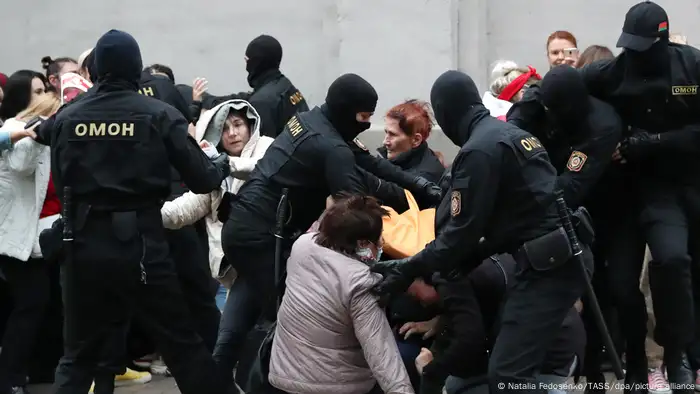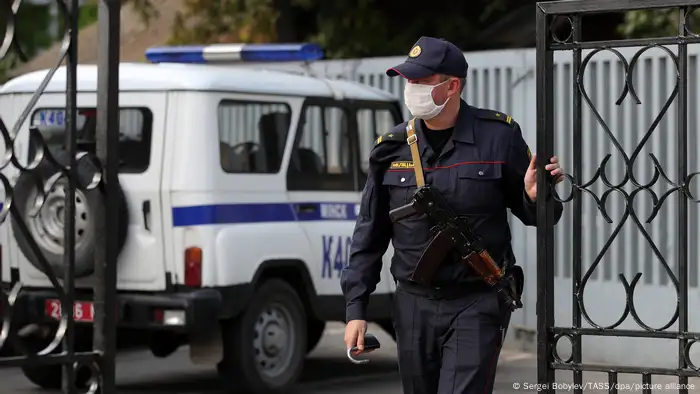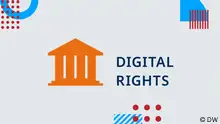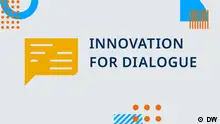Podcast
Iryna Vidanava | Survive and Thrive: The Media Viability Podcast E01 Transcript
For the first episode of "Survive and Thrive", we spoke to Iryna Vidanava. She's the founder and CEO of CityDog, a Belarusian online magazine originally based in Minsk but now operating from exile.

September, 2020: People rally in support of journalists detained during protests. Since the announcement of the 2020 Belarusian presidential election results in August, mass protests against the election results had been erupting across Belarus
Welcome to "Survive and Thrive", DW Akademie's dialogue with media managers on innovative and sustainable business models in a challenging global media landscape. We'll talk about motivation, lessons learned, funding models, decisions both good and bad, and recipes for success.
I'm Janelle Dumalaon, DW Business news anchor and your media viability podcast host. Let's begin! I'd like to welcome Iryna Vidanava, founder and CEO of CityDog. Hi Iryna!
Iryna Vidanava: Hello!
Before we hear more about you and CityDog, I thought we'd start with a short burst of questions.
What's your business model in a catchphrase?
The business model is based on the notion of native advertising. Native advertising has different definitions but for us, it was sponsored content created by the editorial team of CityDog but paid by a partner, be it a private company or an angel. So it can be different partners and it's usually longer-term projects for three to nine months based on a certain topic. But what's important is that the project itself must be of interest and offer value to our audience.
Did you ever manage a moment when everything seemed lost?
Many times throughout these ten years! From the beginning when nobody believed that it was possible to run an independent magazine in Belarus and be commercially sustainable and successful, to the very last year when we had to relocate from Belarus because of the repressions.
What would you need to thrive in the future?
To believe in what we do, to believe that our magazine or our publication matters to us and our audience, and to keep pushing. To keep going.
We're talking about CityDog today, a media website that's blocked and censored in Belarus. But instead of closing down Iryna found a business model which has allowed her to continue working.
Iryna, tell us about CityDog. Who is it that you're trying to reach and with what?
Originally, CityDog which was launched in 2012 was the first and only digital city magazine in Minsk. We were capturing the moment when Minsk was changing from its post-soviet past to becoming a really thriving European city yet based in a dictatorship.
We were trying to highlight all types of civic and urban activism to bring together different groups of people from different fields of activities, be it business, civil society, media, or culture. We wanted to become a platform where people would be discussing the future of their city, and its present, and transforming it together. So, that was the story of CityDog.
We thought of ourselves as a niche magazine initially. And then we grew to over one million visitors per month which was way higher than I ever dreamed of. And then we started expanding our vision and mission - but at the core is still being a magazine embedded within the society. The name, CityDog, refers to a dog running around the city sniffing out different uncommon news. We are not a news media, we're all about storytelling.
And then 2020 came when the last presidential elections in Belarus took place - of course, they were fraud - followed by mass protests, as you might remember. And with it came a crackdown on the media. The media were at the front line and one of the first hits was against the media we continued working inside of the country.
We wanted to stay with our audience, next to it in the struggle, for as long as we could. Yet because hundreds of websites were blocked, journalists and media professionals were put in prison and sentenced to dozens of years in prison it became impossible to carry on our mission without compromising on it. That's why we decided to relocate. So now we are a magazine about Minsk, Belarus, and Belarusians everywhere.

September, 2020: In Minsk, law enforcement officers detain participants in a march held by opposition activists
For our listeners who are just learning about Belarus: Why is the media landscape in Belarus so repressive?
Well, because the media were the mobilizing force behind all the protests and peaceful demonstrations in 2020 and a long time before that. Media are powerful in organizing people and opening eyes to certain things which the government wants to hide. So, it's no wonder that the media often become one of the first targets for authoritarian regimes or dictators.
You yourself have been targeted and you've already said that you've had to relocate. What else has that meant for your outlet?
Before moving abroad, we were nicely located in one city, targeting young professionals, the creative class of Minsk. We knew all the places our readers would visit. We were part of the same community. Our audience was actually very united and clear and understandable for us and ourselves.
Now, hundreds of thousands of Belarusians have fled the country because of the repressions and our audience is also distributed across different countries. It's not a young person sitting in Minsk anymore. Most likely, it might be a young woman somewhere in Poland, Lithuania, Georgia or somewhere else in the world.
So of course we also had to change our look and understanding of our target audience - but remain true to our core mission. And that core mission still is to build a community of active Minskers and active Belarusians. If before we were focusing more on how to develop our city into a nice place, now we have to focus on how to rebuild our country and how we imagine the future for it even when everything looks so grim - especially with the war in Ukraine and continuous repressions in Belarus itself.
Is it fair to describe you as a media outlet in exile for exiles?
No, I wouldn't and I think it's important not to put us in this basket. We describe ourselves as a Belarusian media abroad. But also, what's important is that not a single independent media has stopped publishing despite the repressions since 2020. We relocated but we continue working with audiences inside of the country as well as outside of the country.
The notion is that one day we will come back. There are still some independent media outlets, mostly local ones inside of the country and therefore it's important for us as an independent media sector to view ourselves as a single media sector of Belarusian independent media inside and outside of the country. But of course when you're not based in your own country and when you're blocked in your own country then you have to diversify the channels of how to distribute your content to people in different locations. Especially if the website as your anchor is not so easily accessible.
I would like to take you up on that point: Can you tell us a little bit more about your business model and your strategy? How are you surviving under these obviously very difficult circumstances?
Of course. The business model as it worked in Belarus doesn't work anymore. As I said, it used to be based on native advertising partnerships. Most of our partners were also Belarusian, or international companies based in Belarus.
I don't think that independent media, any kind of media in Belarus can be viewed as businesses now. It's a mission. The business model switched to non-commercial funding, let's put it this way.
But the media also changed. Before 2022, CityDog was present on all social media and popular there. But still, we saw ourselves as a website-based magazine. The website was the platform that we wanted to lead the audience to. Now, when the website is blocked inside of the country and of course also pessimized by the search engines, what do you do?
About a year ago, we started this transition from being website-first to being multi-platform. By saying that I mean that it's not that we just distribute our content created for the web through other platforms. We rather think of the content at the creation stage as how it can be told as a self-sustainable story on the specific platform so that it's native in its format for example on Instagram, Facebook, TikTok or on the website. This actually changed the whole mindset of the editorial team.
Before, we would imagine the story for our reader for the website and then afterward think about how to repackage it for social media. Now, when we are brainstorming the stories we are already thinking about how the story can be told on Instagram understanding that most likely our followers on Instagram will never get to the website. That actually helped us to grow our audience tremendously and changed the way how we think about ourselves as a media.
How does your audience find you? Is it easier to find new audiences that weren't already following your publication before?
For us, the goal was not so much to find new audiences because we were already quite a big media brand for the target audience we defined. It was how to regather, recapture and unite those audiences with the same mission, vision, and brands that we had because it our audience had become very fragmented.
Over the last year, we were building the CityDog media brand across different platforms, so that no matter where you saw our story you knew it was CityDog. My goal as a leader of this organization would be to for example hear from you 'I've seen it on CityDog'. It shouldn't matter whether you've seen it on TikTok, Instagram, or on the website and I think we are getting there.
You've talked quite a lot about distribution but I imagine that it's quite difficult to sustain these operations. How are you how are you financing? How is everyone getting paid? How are you surviving as an organization?
Today, it's thanks to international assistance. It wouldn't be otherwise possible. Business is just not possible in Belarus. We're still generating some revenue through display ads and some occasional native advertising projects.
I think, after a year of crisis management, we are now again in the strategic and growth mode. I hope that the next step will be rediscovering various ways of monetization, looking more specifically into how we can do what we were doing in Belarus as a native advertising model on the web. How could we maybe do it using our social media platforms? This will be the next step. Our original business model was disrupted by this tremendous crisis. But again, I see potential in it and how it can be reshaped for the new setting we're in now.
You've spoken of a crisis management year. You were cut off from your audience. You had to find alternative ways to get your content in front of the eyes that you wanted it in front of. Are you going to be facing further challenges regarding your publication and what you want to do?
I'm sure I will because the repressions never stopped. We still have people inside of the country under cover. That's why you won't find any names on CityDog. It's a pity because we are proud of what we are doing, our authors are proud of their work and our readers would love to know the names. Sometimes they can guess from social media who is doing what but we can't put the names on the website because it would put the journalists at risk.
So, blocking websites is one thing the regime does. But many media in Belarus were also labeled as extremist formations just for doing their work. If your media outlet is labeled extremist then for readers or users it's a criminal offense not only to read it but especially to share or like your content. They can go to prison.
You have to keep in mind that you are trying to do something important but you also have to understand that there might be consequences not only for your media team but also for the audience. You have to really think about it when you are producing the content.
Iryna, how have these restrictions changed the content that you're trying to produce?
When we were based in Belarus, we really had to be very careful, and at some point, for me personally, it made it very hard to motivate myself to keep doing it. I felt that we couldn't fulfill our mission.
I will just give you a very concrete example: We were highlighting featuring a lot of different kinds of civic activists - not necessarily the organizations but the actual people because that's what is interesting for the audience. But over the last couple of years hundreds if not thousands of NGOs, non-governmental organizations, were officially closed down by the government, many of them also labeled extremists.
So, what we had been doing naturally for 10 years we couldn't do anymore. By spotlighting those initiatives we would send these people to prison. For me, that was really one of the toughest moments which lasted for months. I couldn't do what we were meant to be doing, the thing we were created for as a magazine.
Now, we are back to featuring those initiatives. There are many of them popping up in different countries and again this civic movement and civic activism is highlighted in the magazine. As I said in the beginning we were initially focused on Minsk.
We are now seeing ourselves as a platform that unites Belarusians everywhere. We want to keep those ties and solidarity which appeared in 2020 so that we together look at and think about the future of the country and don't give up. Therefore CityDog still remains a very positive media. We are not naive. We understand that things are really bad. We do write a lot about political prisoners and their families and how to help. But at the same time, we want to give our readers a sense of normality because life goes on in all its different aspects. And we also want to inspire them to do something and not just to feel a victim of the circumstances. That's a big task and it's a challenge but I think that it's important to keep doing it.

September, 2020: A police officer closes the gates outside the Directorate of Internal Affairs for Oktyabrsky District, where detained journalists covering an unauthorized protest are kept
I can also imagine that you have to motivate your team a lot and that you have to do a lot to reassure them that they will be protected, that they will be secure. How do you protect the journalists working under you?
I'm very lucky with having a very motivated team. Nobody left since 2020. The team is very horizontal, we are four co-founders and we are equal. It's a very democratic structure. For us co-founders, it's our third media outlet. We've been doing it for 20 years since we were students in a country that was never media-friendly. We are kind of tough enough to understand that this period of time will end.
Then, of course, it's also our responsibility to be very honest with the team and explain the risks. We have to understand that people might get burned out at some point. We also have security protocols. We had prepared security protocols for different scenarios by August 2020. Nobody could imagine the extent of brutality but we were more or less prepared for what might happen and we had protocols for how to act. We talked with the team about that and then again we have to be honest: People should understand that as much as I will do everything to protect them I cannot guarantee their safety. I cannot guarantee that their families will not be affected. In this part, you really have to be honest.
And finally, we are now offering psychological support. I know that it's kind of a new thing in the media field but we start to realize that this is very much necessary. The work is so stressful for us, even more in these circumstances. This kind of therapy should be in place.
Are you ever personally afraid?
Of course. I have been participating in demonstrations since I was a student in the late 90s. 2020 wasn't the first time people were beaten and arrested in Belarus. It was just at a scale that opened the eyes of the world, and it was happening there in the center of Europe.
Every time, when you are part of a peaceful demonstration for the right cause and you are a journalist likely with a microphone, you know that you will be among the first targets. And of course, you are scared. It's normal.
But then you feel the shoulder of others and in Belarus, it's often the shoulder of another woman like myself, not a big one, and then you do feel this empowerment and you just have to overcome this moment of fear. But of course, I'm also scared and afraid for the people who are in the country, for my family and I understand that this regime knows no limits. But if we give up, then it will be up to the next generations to clear the mess. We have to do it.
This is a bit of a philosophical question: Your job as a media practitioner working under repression is not going to be the same as a journalist who enjoys freedom. Would you say that journalism under repressive conditions necessarily has to have an activist quality to it?
Not necessarily. I think it really very much depends on the media outlet. My media does have this activist position. I think in Belarus most of the independent media would have to take an activist standpoint. But then, if you are a news media outlet you have a job as a reporter, you are just reporting you are not taking sides.
I think that what's nice about the media industry these days: it's very diverse. You can find all types of media with different angles to them. For non-news media, it's absolutely normal to focus on the storytelling, features, and evergreen content and we do a lot of that. Having said that, you have to be balanced. You have to fact check and you have to be very vigorous - even more, if you are in this kind of activist media position. You have to be able to prove that what you are doing is real and not just some imaginary reality.
Can you take us through an example of a story that you would do and how you would distribute it according to on which platform which part of the story belongs?
Yes, one recent example: We did a long read for the website on which streets in Minsk have to be renamed and why. We did this long piece for the website but it had all the components for being reformatted for other platforms.
On the website, you would find expert opinions explaining why and how the streets were named like that and then there were big pieces on each street: Who is a street named after and why? Is it a good idea? And maybe some suggestions on how to rename them. Very long pieces, unreadable on any other platform. But for this topic, we also created info cards, we had photos that were very recognizable for Minskers.
Then for Instagram, we created carousels: a photo of the street and a quick explainer of who it's named after and why it's wrong. It also worked perfectly on TikTok: We used the cards with the photos of the historical figures for who the streets are named and again, explained why those streets should be renamed. So, on the website, it got like about 20,000 views and quite a few comments. On Instagram, it was about 20,000, just the carousel.
And on TikTok, it was almost 200,000. So that is one story that sorts through in a way that you can easily adapt it for other platforms: native for the users, understandable formats, and then you generate a much higher reach than you would do otherwise.
What sort of general response has your work gotten from the audiences? You've talked about this particular story and how well it's done on the different platforms in which you're present but what's the response been especially through all of these changes that you've experienced?
We do have a very good connection with our audience. We crowdsource a lot. We often engage with our audiences by asking them questions so that they either help us to find the right people to feature or the right new angles of the story or even new topics. Sometimes it's really, really touching.
For example, when we ran a story of a former political prisoner girl who was sentenced to several months in prison. She's an artist and after she came out of prison, she created a 3D model of the cell. There is no public information about how prisons are actually working on the inside but there are lots of stories of how inhumane the conditions created there for the political prisoners are. She created this 3D model of the cell where she was kept and it gave all of us an idea of what it's like inside, and how it looks. You just could immerse yourself there and feel how small it is, how overcrowded.
Then, we were contacted by another former political prisoner who was working on a similar project. He asked us to put him in touch with her so that they could work together and create a bigger project. This kind of feedback, this kind of impact just really motivates you to keep doing what you're doing.
I also just wanted to ask you: You could very well end up on the other side of the equation. You could become a political prisoner yourself. Your colleagues could become political prisoners. What does that mean for planning cycles for your institution? How far ahead in the future can you think, two years, three years?
Even two years is a luxury. I would say the horizon now is one year and it's also a constant race because we are not an institution that has funding coming from a budget. It's basically project-based. It's my job to make sure that I can provide for the team and also that this can be managed by other people if something happens to me.
There might be no one-fits-all solution for public interest media outlets in autocratic countries like Belarus but maybe you can name three best practice tips as to how media in these countries could survive.
You have to diversify: diversify your content, diversify your platforms, and diversify your channels of distribution.
You also have to experiment and innovate - in the media in general, but in these countries even more. Because what worked yesterday will not work tomorrow. You have to try to look into the future today and to find the way how and what you will do tomorrow.
The third component I think is crucial, I probably should have started with it: solidarity, openness, and support of each other. That's I think what makes the Belarusian independent media sector so resilient despite 20 years of repression and suppression. We were always very open about learning from each other, providing assistance to each other, and organizing ourselves to help in different ways depending on what period of time we are talking. This notion of solidarity and unity is extremely, extremely important for the media operating in authoritarian regimes.
Earlier, you outlined your vision. How do you know when you've succeeded?
When Belarus is free.
Iryna Vidanava, founder and CEO of CityDog, thank you so much for all your time today we really enjoyed hearing from you.
This transcript of episode one of "Survive and Thrive: The Media Viability Podcast" has been lightly edited for clarity.
Get in touch
For questions and suggestions write to dw-akademie.surviveandthrive@dw.com
Or find us on Twitter, Facebook, LinkedIn and Youtube.
This podcast is produced by DW Akademie and is supported by the Federal Ministry for Economic Cooperation and Development.
WWW links
Audios and videos on the topic
- Date 28.04.2023
- Keywords DW Akademie, media viability, Belarus, survive and thrive, podcast, transcription
- Feedback: Send us your feedback.
- Print Print this page
- Permalink https://p.dw.com/p/4Pvml
- Date 28.04.2023
- Keywords DW Akademie, media viability, Belarus, survive and thrive, podcast, transcription
- Send us your feedback.
- Print Print this page
- Permalink https://p.dw.com/p/4Pvml





